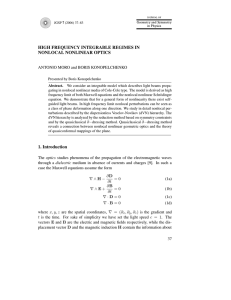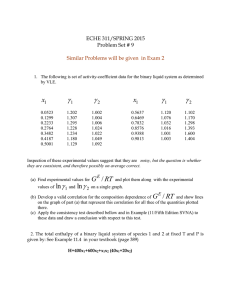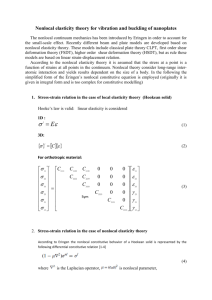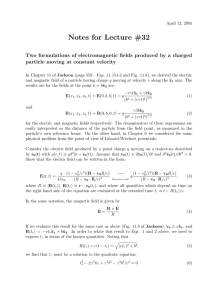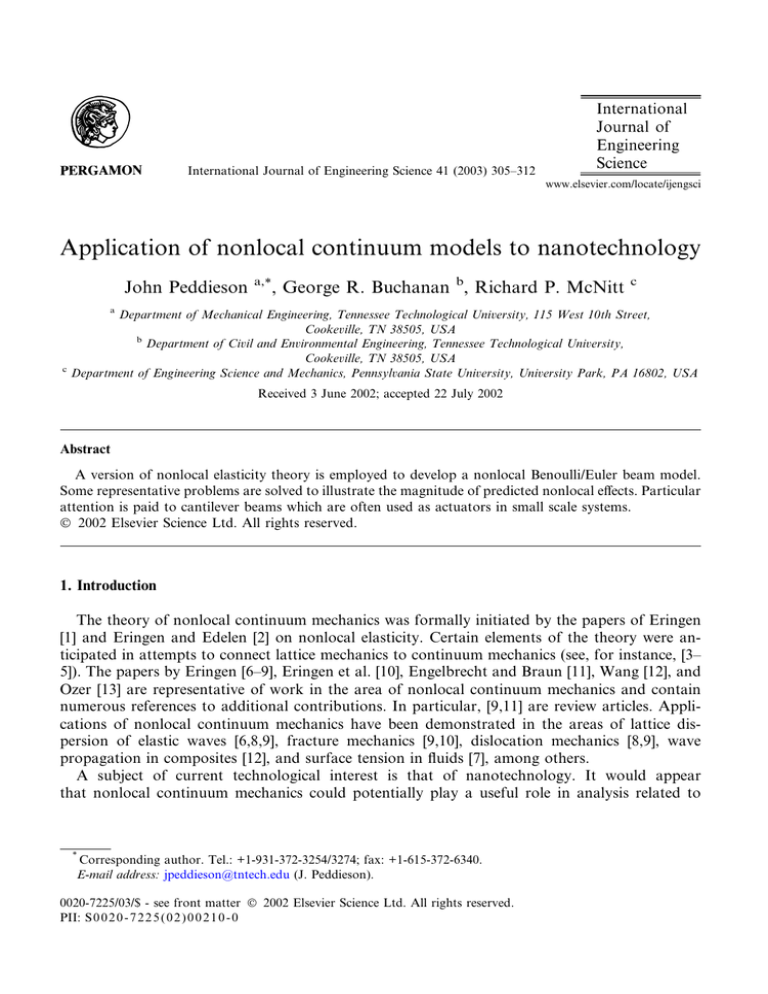
International Journal of Engineering Science 41 (2003) 305–312
www.elsevier.com/locate/ijengsci
Application of nonlocal continuum models to nanotechnology
John Peddieson
a,*
, George R. Buchanan b, Richard P. McNitt
c
a
c
Department of Mechanical Engineering, Tennessee Technological University, 115 West 10th Street,
Cookeville, TN 38505, USA
b
Department of Civil and Environmental Engineering, Tennessee Technological University,
Cookeville, TN 38505, USA
Department of Engineering Science and Mechanics, Pennsylvania State University, University Park, PA 16802, USA
Received 3 June 2002; accepted 22 July 2002
Abstract
A version of nonlocal elasticity theory is employed to develop a nonlocal Benoulli/Euler beam model.
Some representative problems are solved to illustrate the magnitude of predicted nonlocal effects. Particular
attention is paid to cantilever beams which are often used as actuators in small scale systems.
Ó 2002 Elsevier Science Ltd. All rights reserved.
1. Introduction
The theory of nonlocal continuum mechanics was formally initiated by the papers of Eringen
[1] and Eringen and Edelen [2] on nonlocal elasticity. Certain elements of the theory were anticipated in attempts to connect lattice mechanics to continuum mechanics (see, for instance, [3–
5]). The papers by Eringen [6–9], Eringen et al. [10], Engelbrecht and Braun [11], Wang [12], and
Ozer [13] are representative of work in the area of nonlocal continuum mechanics and contain
numerous references to additional contributions. In particular, [9,11] are review articles. Applications of nonlocal continuum mechanics have been demonstrated in the areas of lattice dispersion of elastic waves [6,8,9], fracture mechanics [9,10], dislocation mechanics [8,9], wave
propagation in composites [12], and surface tension in fluids [7], among others.
A subject of current technological interest is that of nanotechnology. It would appear
that nonlocal continuum mechanics could potentially play a useful role in analysis related to
*
Corresponding author. Tel.: +1-931-372-3254/3274; fax: +1-615-372-6340.
E-mail address: jpeddieson@tntech.edu (J. Peddieson).
0020-7225/03/$ - see front matter Ó 2002 Elsevier Science Ltd. All rights reserved.
PII: S 0 0 2 0 - 7 2 2 5 ( 0 2 ) 0 0 2 1 0 - 0
306
J. Peddieson et al. / International Journal of Engineering Science 41 (2003) 305–312
nanotechnology applications. The present work explores this potential in the context of a specific
application.
The length scales associated with nanotechnology are often sufficiently small to call the applicability of classical continuum models into question. Atomic and molecular models, while
certainly conceptually valid for small length scales, are difficult to formulate accurately and are
almost always computationally intensive. Nonlocal continuum models represent attempts to extend the continuum approach to smaller length scales while retaining most of its many advantages.
A problem of current interest is the development of small actuators in the form of cantilever
beams exhibiting elastic response. In the classical (local) elastic model the stress state at a given
point is regarded as being determined uniquely by the strain state at that same point. In the
nonlocal model, on the other hand, the stress state at a given point is regarded as being determined by the strain states of all points in the body. This recognizes the finite range of interatomic
and intermolecular forces. While the constitutive equation of classical elasticity is an algebraic
relationship between the stress and strain tensors, that of nonlocal elasticity involves spatial integrals which represent weighted averages of the contributions of the strain tensors of all points in
the body to the stress tensor at the given point. Under certain conditions these integral constitutive equations can be converted to equivalent differential constitutive equations.
In the present work, the Bernoulli/Euler beam model is extended to include nonlocal elastic
material response. Issues related to boundary conditions are discussed and several closed form
solutions are presented. An attempt is then made, based on these solutions, to identify the
parametric range for which nonlocal effects will be important in practical actuator applications.
2. Governing equations
The most general form of the constitutive equation for nonlocal elasticity involves an integral
over the entire region of interest. This integral contains a kernel function which describes the
relative influences of strains at various locations on the stress at a given location. The interaction
of boundary conditions with the resulting integrodifferential equations has not been studied extensively. It is beyond the scope of the present work to make a contribution to this interesting
subject. For this reason, use will be made of some results obtained by Eringen [8]. It is shown
therein that the integral constitutive equation can be converted exactly into a corresponding
differential form for some kernels. This approach will be taken in the work described below. Once
the final equations have been obtained, an alternative interpretation will be discussed.
Fig. 1 schematically describes the beam under discussion and serves to introduce the axial
coordinate x, the transverse coordinate y, the beam length L, the beam bending stiffness EI, and
the loading per unit length p. Fig. 2 shows a loaded infinitesimal element and serves to introduce
the shear force V and bending moment M and indicate their positive directions. Equilibrium
considerations produce the usual results (with a superposed prime denoting differentiation with
respect to x)
V 0 þ p ¼ 0;
M0 þ V ¼ 0
ð1a; bÞ
J. Peddieson et al. / International Journal of Engineering Science 41 (2003) 305–312
307
Fig. 1. Geometry and coordinate system.
Fig. 2. Loaded infinitesimal element.
and the combination of Eqs. (1a,b) yields
M 00 ¼ p
ð2Þ
The Bernoulli/Euler beam model is based on the assumption that the beam consists of fibers
parallel to the x axis, each in a state of uniaxial tension or compression. The same approach is
used herein with the uniaxial HookeÕs law replaced by
r ðe0 aÞ2 r00 ¼ Ee
ð3Þ
where r is the axial stress, e is the axial strain, E is YoungÕs modulus, a is the internal characteristic
length, and e0 is a constant. Eq. (3) is the uniaxial stress version of Eq. (3.19) of [8]. The small
deflection Bernoulli/Euler relation between strain and curvature is
e ¼ yv00
ð4Þ
where v denotes the beamÕs transverse displacement. Combining Eqs. (3) and (4) gives
r ðe0 aÞ2 r00 ¼ Eyv00
ð5Þ
Fig. 3 shows the force acting on a differential cross-sectional element, the moment resultant of
the corresponding stress distribution, and indicates that
308
J. Peddieson et al. / International Journal of Engineering Science 41 (2003) 305–312
Fig. 3. Loaded area element and bending moment.
M ¼
Z Z
ð6Þ
ry dA
A
Multiplying Eq. (3) by y dA and integrating the result over the area A yields
M ðe0 aÞ2 M 00 ¼ EIv00
ð7Þ
where
I¼
Z Z
y 2 dA
ð8Þ
A
is the usual area moment of inertia of the cross section. Eq. (7) is the nonlocal Bernoulli/Euler
moment/curvature relation. Using Eq. (2), it can also be written
M ¼ EIv00 þ ðe0 aÞ2 p
ð9Þ
Substituting Eq. (9) into Eqs. (1b) and (2) yields
2
V ¼ ðEIv000 þ ðe0 aÞ p0 Þ
ð10Þ
vIV ¼ ðp ðe0 aÞ2 p00 Þ=ðEIÞ
ð11Þ
and
Eq. (11) is the nonlocal Bernoulli/Euler beam deflection equation.
Eqs. (9)–(11) constitute the nonlocal Bernoulli/Euler beam model based on the constitutive
equation described by Eq. (3.19) of [8]. It can be seen that the beam deflection equation has the
same order as that of the local model (to which it reduces for a ¼ 0) and that nonlocality is
manifested by spatial variation of the applied load.
There is an alternate interpretation of Eqs. (9)–(11). Expansion of the general integral constitutive equation of nonlocal elasticity [8, Eq. (3.17)] for e0 a=L 1, retention of only the first two
terms, and simplification to the case of uniaxial stress produces
r ¼ E e þ ðe0 aÞ2 e00
ð12Þ
J. Peddieson et al. / International Journal of Engineering Science 41 (2003) 305–312
309
Substituting Eq. (4) into Eq. (12), substituting the result into Eq. (6), performing the indicated
integration, and using Eq. (8) leads to
M ¼ EI v00 þ ðe0 aÞ2 vIV
ð13Þ
Substituting Eq. (13) into Eqs. (1b) and (2) yields
V ¼ EI v000 þ ðe0 aÞ2 vV
ð14Þ
vIV þ ðe0 aÞ2 vVI ¼ p=ðEIÞ
ð15Þ
and
Eqs. (12)–(15) can be thought of as constituting a ‘‘strain gradient’’ form of the Bernoulli/Euler
beam model. Unlike Eq. (11), Eq. (15) is of higher order than that of the local Bernoulli/Euler
beam model and its solution would require additional boundary conditions which are not
physically obvious. This issue could perhaps be settled by the use of a variational approach. This
is not pursued herein and is probably not necessary if it is recognized that Eqs. (12)–(15) hold only
for e0 a=L 1. Identifying the terms multiplied by ðe0 aÞ2 in Eqs. (12)–(15) as second order terms
and recalling that, to second order, no accuracy is lost by simplifying second order terms using the
first order equations reveals that the respective Eqs. (12)–(15) are equivalent to Eq. (3) and Eqs.
(9)–(11). Thus these equations can be regarded as either exact for a specific nonlocal kernel or
approximate for general nonlocal kernels.
3. Results and discussion
As a simple first example consider the case of a simply supported beam for which
vð0Þ ¼ 0;
vðLÞ ¼ 0;
Mð0Þ ¼ 0;
MðLÞ ¼ 0
ð16a–dÞ
loaded by a distributed load
ð17Þ
p ¼ p0 sinðnpx=LÞ
where p0 is a constant and n is a positive integer. Solving the combination of Eqs. (11) and (17)
subject to Eqs. (16a,b); the combination of Eqs. (9), (16c), and (17); and the combination of Eqs.
(9), (16d), and (17) yields
2
4
v ¼ ð1 þ ðne0 a=LÞ Þðp0 L4 =ððnpÞ EIÞÞ sinðnpx=LÞ
ð18Þ
Defining (here and subsequently) d to be the nonlocal maximum deflection and d0 to be the
corresponding local maximum deflection gives
310
J. Peddieson et al. / International Journal of Engineering Science 41 (2003) 305–312
d=d0 ¼ 1 þ ðne0 a=LÞ2
ð19Þ
Eq. (19) illustrates the obvious point that it is not the ratio of internal characteristic length to
beam length (a=L in this case) but, rather, the ratio of internal characteristic length to length
representative of load change (na=L in this case) which determines the importance of nonlocal
effects. Eringen [8] gives e0 ¼ 0:39. Using e0 ¼ 2=5 (here and subsequently) for convenience, Eq.
(19) shows that d will be less than 1% above d0 for
ð20Þ
L=a > 4n
which increases linearly with n.
The primary interest of the present work is in the load/deflection equation for a cantilever beam
used as an actuator. If the fixed end is at x ¼ 0, the boundary conditions are
vð0Þ ¼ 0;
v0 ð0Þ ¼ 0;
MðLÞ ¼ 0;
V ðLÞ ¼ P0
ð21a–dÞ
where P0 is the concentrated force applied at the tip (if any).
First, consider the case of concentrated tip loading, that is
p¼0
ð22Þ
Solving the combination of Eqs. (11) and (22) subject to Eqs. (21a,b);the combination of Eqs. (9),
(21c), and (22); and the combination of Eqs. (10), (21d), and (22) produces
2
v ¼ ðP0 L3 =ð6EIÞÞðx=LÞ ð3 x=LÞ
ð23Þ
which is identical to the local result. This is illustrative of the general property (inherent in the
structure of Eqs. (9)–(11)) that any beam segment which is not acted upon by a distributed load is
governed by the local equations. In addition, the fact that nonlocality does not affect Eqs. (1)
(equilibrium conditions) dictates that jump conditions across concentrated forces and moments
will be the same as those for the local model. Thus, for example, if the concentrated force were
located at x ¼ fL (0 < f < 1), Eq. (23) would be modified to
2
ð3f x=LÞ; x=L < f
ð24Þ
v ¼ P0 L3 =ð6EIÞ ðx=LÞ
2
x=L > f
f ð3x=L f Þ;
which is also the classical result. By superposition, the nonlocal model under discussion herein
predicts no nonlocal effects will be exhibited by a cantilever subjected to any combination of
concentrated loads.
Second, consider the case of uniformly distributed loading, that is
P0 ¼ 0;
p ¼ p0
ð25a; bÞ
Solving the combination of Eqs. (11) and (25b) subject to Eqs. (21a,b); the combination of Eqs.
(9), (21c), and (25b); and the combination of Eqs. (10), (21d), and (25) yields
J. Peddieson et al. / International Journal of Engineering Science 41 (2003) 305–312
v ¼ ðp0 L4 =ð24EIÞÞðx=LÞ2 ð6ð1 2ðe0 a=LÞ2 Þ 4x=L þ ðx=LÞ2 Þ
311
ð26Þ
From Eq. (26) can be deduced the result
d=d0 ¼ 1 ð2e0 a=LÞ2
ð27Þ
For e0 ¼ 2=5, d will be less than 1% below d0 for
ð28Þ
L=a > 8
For uniformly distributed loading, the nonlocal effect manifests itself only in Eq. (9), but this is
sufficient to produce a deviation from the local deflection results.
Third, consider the case of a variable distributed load described by
P0 ¼ 0;
p ¼ p0 ðx=LÞn ;
n ¼ 0; 1; 2; . . .
ð29a; bÞ
This loading is characterized by a respective resultant force magnitude and location
P ¼ p0 L=ðn þ 1Þ;
x ¼ ðn þ 1ÞL=ðn þ 2Þ
ð30a; bÞ
and was selected so that nonlocal effects will be present in all of Eqs. (9)–(11).
Solving the combination of Eqs. (11) and (29b) subject to Eqs. (21a,b); the combination of Eqs.
(9), (21c), and (29b); and the combination of Eqs. (10), (21d), and (29) leads to
v ¼ p0 L4 =ððn þ 1Þðn þ 2Þðn þ 3Þðn þ 4ÞEIÞ ðn þ 1Þðn þ 3Þðn þ 4Þ=2
2
nþ2
nþ4
ð31Þ
ððn þ 2Þðn þ 3Þðn þ 4Þ=6Þðx=LÞ ðn þ 3Þðn þ 4Þðe0 a=LÞ ðx=LÞ þ ðx=LÞ
This expression leads to the result
2
d=d0 ¼ 1 ðe0 a=LÞ =ð1=ððn þ 3Þðn þ 4ÞÞ þ ð2n þ 1Þ=6Þ
ð32Þ
For e0 ¼ 2=5, d will less than 1% below d0 for
L=a > 4=ð1=ððn þ 3Þðn þ 4ÞÞ þ ð2n þ 1Þ=6Þ1=2
ð33Þ
If Eq. (30a) is used to eliminate p0 in favor of P in Eq. (31) and the limit of the result is taken as
n ! 1, Eq. (23) is obtained (with P0 replaced by P ). Substituting n ¼ 0 into Eq. (31) produces Eq.
(26). Thus, Eqs. (31) and (33) contain the results for concentrated tip loading and uniformly
distributed loading as special cases. The load becomes increasingly concentrated in the vicinity of
the tip as n increases.
The largest value of the right hand side of Eq. (33) occurs at n ¼ 0 (in which case Eq. (33)
becomes identical to Eq. (27)). The right hand side of Eq. (33) uniformly decreases as n increases
through positive integer values. Thus Eq. (27) is indicative of the largest nonlocal effect associated
with the family of loads described by Eq. (29b).
312
J. Peddieson et al. / International Journal of Engineering Science 41 (2003) 305–312
Typical microelectromechanical systems (MEMS) cantilever actuators have lengths of the
order of 100–500 lm (1 104 m < L < 5 104 m). Typical interatomic distances, on the
other hand, are on the order of angstroms (1 1010 m < a < 1 109 m). Eq. (33) predicts,
therefore, that nonlocal effects would not manifest themselves for MEMS devices of this kind.
Proposed nanotechnology devices are envisioned to have lengths on the order of nanometers
(1 109 m < L < 1 108 m). For devices of this size, Eq. (33) predicts that nonlocal effects
could be significant.
4. Conclusion
A version of nonlocal elasticity proposed by Eringen [8] has been used to formulate a nonlocal
version of Bernoulli/Euler beam theory. Four representative problems were solved and the results
were used to estimate the importance of nonlocal effects. For the important case of cantilever
actuators, the model predicts that MEMS scale devices would not exhibit nonlocal effects while
nanoscale devices could.
References
[1] A.C. Eringen, Int. J. Eng. Sci. 10 (1972) 1.
[2] A.C. Eringen, D.G.B. Edelen, Int. J. Eng. Sci. 10 (1972) 233.
[3] J.A. Krumhansl, Some considerations of the relation between solid state physics and generalized continuum
mechanics, in: Mechanics of Generalized Continua, Springer-Verlag, New York, 1968, p. 298.
[4] R.D. Midlin, Theories of elastic continua and crystal lattice theories, in: Mechanics of Generalized Continua,
Springer-Verlag, New York, 1968, p. 312.
[5] I.A. Kunin, The theory of elastic medic with microstructure and the theory of dislocations, in: Mechanics of
Generalized Continua, Springer-Verlag, New York, 1968, p. 321.
[6] A.C. Eringen, Int. J. Eng. Sci. 10 (1972) 425.
[7] A.C. Eringen, Int. J. Eng. Sci. 10 (1972) 561.
[8] A.C. Eringen, J. Appl. Phys. 54 (1983) 4703.
[9] A.C. Eringen, Int. J. Eng. Sci. 30 (1992) 1551.
[10] A.C. Eringen, C.G. Speziale, B.S. Kim, J. Mech. Phys. Solids 25 (1977) 339.
[11] J. Engelbrecht, M. Braun, Appl. Mech. Rev. 51 (1998) 475.
[12] Y.S. Wang, Mech. Res. Comm. 26 (1999) 719.
[13] T. Ozer, Mech. Res. Comm. 26 (1999) 725.

